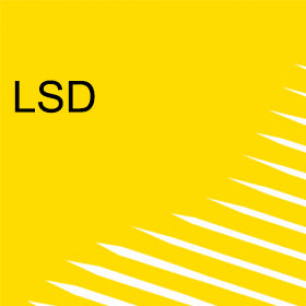LSD
acid, tabs, trips, blotters, microdots
What is LSD?
Lysergic acid diethylamide (LSD) is a hallucinogenic drug that produces powerful sensory distortions, intensifies mood and alters thought processes.
LSD is usually prepared in liquid form, which is then dropped onto small pieces of blotting paper known as ‘tabs’.
LSD is usually taken orally, either through swallowing or sublingual (under the tongue) administration. In rare cases, LSD is inhaled, injected or applied to the skin (Quick Guide to Drugs and Alcohol, 2017).
What are the effects?
The effects of LSD are usually experienced 20-60 minutes after administration. People typically report effects for six to 11 hours, but this period can be longer depending on the dose.
The effects of LSD depend on the quantity consumed, the person’s height and weight, their general health, their mood, their past experience with LSD, whether they use LSD on its own or with other drugs and the composition of the drug.
Acute effects may include:
- Euphoria and sense of wellbeing
- Vivid perceptual distortions (hallucinations)
- Distorted sense of time and place
- Rapidly changing emotions
- Altered state of thinking and depersonalisation
- Increased body temperature, heart rate and blood pressure
- Insomnia, dizziness and nausea
- Poor coordination
- Paranoia, panic, anxiety
Long term effects may include:
- Flashbacks
- Hallucinogen persisting perception disorder (HPPD)
- Personality disruption, depression, and poorer memory (Quick Guide to Drugs and Alcohol, 2017)
What are the risks?
People who use LSD can sometimes experience a ‘bad trip’, involving a disturbing hallucination. This can lead to panic and risky behaviour (ADF, 2020).
Overdose, psychological dependence, and ‘flashbacks’ are also risks when using LSD.
Mixing LSD with other drugs
The effects of taking LSD with other drugs − including over-the-counter or prescribed medications − can be unpredictable and dangerous, and could cause:
- LSD and methamphetamine or MDMA can increase the chances of a bad trip and can also lead to panic
- LSD and alcohol may increase nausea and vomiting (ADF, 2020).
Toxicity and overdose
LSD is not a particularly toxic drug and deaths that have been linked to LSD are usually unintended consequences of perceptual distortion (like falls). Despite this, taking a larger than intended dose can result in extremely distorted perception, unstable or depressed mood, or intense fear (Quick Guide to Drugs and Alcohol, 2017).
Dependence and withdrawal
LSD is not thought to cause physical dependence, however people may develop psychological dependence although this is not common (Quick Guide to Drugs and Alcohol, 2017).
Mental health
Hallucinogens have the potential to give rise to psychotic symptoms, sometimes known as a ‘bad trip’. It’s been found that following a single dose healthy volunteers can experience both positive and negative psychotic symptoms (Darke, Lappin & Farrell, 2019).
How many people use LSD?
According to the Australian Institute of Health and Welfare, use of hallucinogens may be increasing. Between 2016 and 2019, lifetime use of hallucinogens increased from 9.4 percent to 10.4 percent and recent use increased from 1.0 percent to 1.6 percent. Most people who used hallucinogens had used LSD/acid/tabs (73 percent) and magic mushrooms/psilocybin (61 percent) in the previous 12 months (AIHW, 2020).
Treatment
People who use LSD do not generally seek treatment from health professionals and there are few treatment options that can be recommended, apart from those found to be generally effective for drug dependence like motivational enhancement, cognitive behavioural therapy (CBT), contingency management, and social support services (Quick Guide to Drugs and Alcohol, 2017).
Emergency info
If you, or someone around you, is experiencing undesired or distressing psychological or physical symptoms from the intake of alcohol or other drugs please seek immediate medical attention.
If you need urgent help from ambulance services call Triple Zero (000). If a person has been mixing drugs with alcohol or other drugs, tell the paramedic exactly what has been taken.
Services
For free and confidential advice about alcohol and other drugs, call the National Alcohol and Other Drug hotline on 1800 250 015.
The hotline will automatically direct you to the Alcohol and Drug Information Service in your state or territory.
More resources
The Illicit Drug Reporting System is an Australian monitoring system that identifies emerging trends of local and national interest in illicit drug markets.
The Ecstasy and Related Drugs Reporting System is an Australian monitoring system for ecstasy and related drugs that identifies emerging trends of local and national interest.
The Clinician’s Guide to Illicit Drugs and Health examines the health effects of each of the major illicit drugs.
The Australian Institute of Health and Welfare collects information on alcohol and tobacco consumption, and illicit drug use among the general population in Australia.
The Australian Bureau of Statistics is Australia’s national statistical agency, providing official statistics on a range of economic, social, population and environmental matters of importance to Australia.
Sources
A Quick Guide to Drugs and Alcohol (3rd ed.) (2017). Sydney, Australia: Drug Info.
Alcohol and Drug Foundation (2020). LSD. Retrieved from https://adf.org.au/drug-facts/lsd/
Australian Institute of Health and Welfare (2020). Australian National Drug Strategy Household Survey 2019. Retrieved from: https://www.aihw.gov.au/reports/illicit-use-of-drugs/national-drug-strategy-household-survey-2019/contents/table-of-contents
Darke, S., Lappin, J., & Farrell, M. (2019). The Clinician’s Guide to Illicit Drugs and Health, Great Britain: Silverback Publishing.


